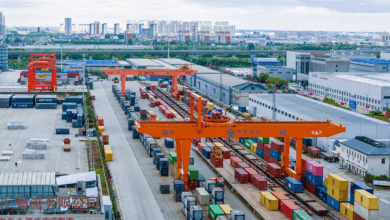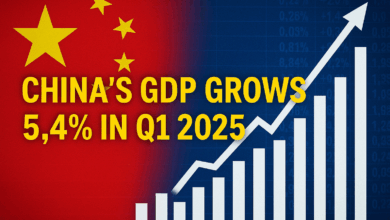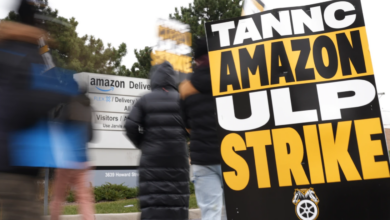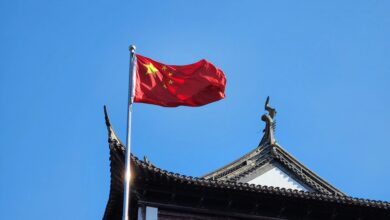UPS to Cut 20,000 Jobs, Close 73 Buildings Amid New Tariffs and Economic Uncertainty

(WE) April 29, 2025 — In a sweeping move to combat what it calls “new or increased tariffs” and a shifting global economy, United Parcel Service (UPS) announced on Monday that it will cut approximately 20,000 jobs and close 73 leased and owned buildings by the end of June 2025. The company cited a turbulent macroeconomic environment and intensifying trade headwinds, including the impact of renewed tariffs under President Donald Trump’s administration, as key reasons for the restructuring.
The announcement came during UPS’s first quarter earnings report, where the Atlanta-based shipping giant posted consolidated revenue of $21.5 billion—down slightly from $21.7 billion during the same period in 2024. The company’s top executives framed the decision as part of a broader initiative to streamline operations and prepare for potentially deeper economic disruptions.
“The actions we are taking to reconfigure our network and reduce cost across our business could not be timelier,” said Carol Tomé, CEO of UPS. “The macro environment may be uncertain, but with our actions, we will emerge as an even stronger, more nimble UPS.”
The Layoff Wave: A Strategic Retrenchment
The 20,000 job cuts are among the largest workforce reductions in UPS’s modern history and follow closely on the heels of 12,000 layoffs the company implemented in January 2024. Those cuts were framed as a necessary step to “align resources for 2024,” saving the company close to $1 billion. The latest round of layoffs is part of a more aggressive three-year cost-saving and network overhaul initiative titled “Network Reconfiguration and Efficiency Reimagined,” which is scheduled to conclude in 2027.
This transformation effort, UPS said, will save the company approximately $3.5 billion in 2025 alone. In its earnings report, UPS emphasized the necessity of reducing its operational footprint by closing 73 facilities across the U.S. and possibly more as the company continues its internal reviews.
“We are continuing to review our network and may identify additional buildings for closure,” the company noted in its earnings documentation.
While UPS did not specify which facilities would be affected, a company spokesperson confirmed that both owned and leased properties would be shuttered, many of which serve as regional distribution and sorting centers. The closures are expected to result in widespread workforce reductions, predominantly hitting warehouse workers, package handlers, and some regional managerial staff.
Trump’s Tariffs and Trade Policy: A Revived Headwind
The timing of UPS’s announcement underscores the renewed impact of U.S. trade policy under President Donald Trump, who returned to office in 2025 following his victory over President Joe Biden in the 2024 election. Trump has vowed to implement a fresh wave of tariffs aimed at reducing America’s trade deficit, increasing domestic manufacturing, and countering what he describes as “economic aggression” from China and other foreign competitors.
These measures, however, have reignited fears of a global trade slowdown—fears that appear to be materializing in companies like UPS that serve as critical arteries for international commerce.
According to CNBC, UPS warned as early as January that it was fast-tracking plans to reduce the number of packages it handles for Amazon.com—its largest customer, which accounted for 11.8% of total UPS revenue in 2024. That move is seen as both a cost-cutting strategy and a hedge against any fallout from Amazon’s decision to reroute deliveries through its own growing logistics network.
Amazon, Tariffs, and a Brewing Political Clash
The political fallout from tariff-related corporate decisions became even more pronounced on April 29 when reports surfaced that Amazon was preparing to display the cost of new tariffs next to product prices on its website. The goal, according to internal Amazon sources, was to increase transparency for consumers by showing how much more they would pay due to policy changes.
That revelation triggered a sharp rebuke from Karoline Leavitt, White House Press Secretary under Trump, who described Amazon’s move as “a hostile and political act.” In a briefing with reporters, Leavitt suggested that Amazon was attempting to turn public sentiment against the administration’s trade policies.
“This is not about transparency; it’s about undermining the president’s efforts to put America first,” Leavitt said. “Major corporations should not weaponize pricing data to carry out political attacks.”
Amazon has yet to publicly respond to the criticism.
A Tough Year for Logistics and E-Commerce
UPS’s latest announcement is emblematic of broader turbulence across the logistics and e-commerce sectors. The company’s core business has faced mounting pressures from shifting consumer habits post-pandemic, rising operational costs, labor contract renegotiations, and aggressive competition from both Amazon and FedEx.
Earlier this year, UPS projected full-year 2025 revenues of approximately $89 billion—a flat or slightly downward forecast compared to previous years. Analysts at Bloomberg and The Wall Street Journal had speculated that any decline in e-commerce demand or disruptions in global supply chains could lead UPS to revise its revenue outlook or implement cost-cutting measures.
Those fears have now materialized.
“When you combine a weakening macroeconomic environment with an aggressive trade war and industry-wide overcapacity, you get exactly this kind of response,” said David Vernon, an analyst at Bernstein Research. “It’s not just UPS; we’re likely to see similar moves across the logistics sector.”
Read More:
- Karoline Leavitt’s Angry New Attack on Amazon Reveals Trump’s Weakness
- Mr. Cooper Joins Rocket Companies in a Landmark $9.4 Billion Mortgage Merger
- Apple to Move US Phone Assembly to India in a Strategic Shift Away from China
UPS and Labor: A Delicate Balancing Act
The impact of the job cuts is likely to reverberate through labor organizations, especially given UPS’s prominent role in unionized logistics. The company employs hundreds of thousands of workers represented by the International Brotherhood of Teamsters, which negotiated a landmark contract agreement in 2023 that included wage increases, improved benefits, and better workplace protections.
Teamsters officials have not yet released a public statement on the layoffs, though insiders say private conversations between union leadership and company representatives have already begun. Union officials will likely push for clarity on whether the layoffs will disproportionately affect union positions and whether workers will be eligible for severance, reemployment assistance, or retraining.
“This is a test of the strength of that contract,” said a union representative who spoke on condition of anonymity. “Our members deserve transparency, dignity, and options—not a pink slip.”
A Glimpse Into UPS’s Future
UPS’s restructuring effort is not purely reactive. According to the earnings report and statements from company leadership, the firm is pursuing long-term transformation goals centered on automation, AI-driven logistics optimization, and a leaner, more sustainable global footprint. The “Network Reconfiguration and Efficiency Reimagined” plan includes investments in smart warehouses, drone-assisted deliveries, and electrified fleets—all part of UPS’s aim to remain competitive in a post-pandemic, digitally transformed economy.
The company also reaffirmed its commitment to environmental sustainability goals, including achieving carbon neutrality by 2050. However, critics argue that the near-term job losses and facility closures are a contradiction to those goals, as they will displace thousands of workers and reduce community infrastructure in mid-sized cities where UPS buildings often serve as major employers.
The Broader Economic Picture
UPS’s downsizing effort arrives at a time when signs of economic strain are emerging across multiple sectors. Retailers are reporting softening consumer demand, manufacturers are grappling with increased material costs, and financial institutions are warning of a possible credit tightening cycle following the Federal Reserve’s cautious monetary policies.
At the international level, trade tensions have escalated not only between the U.S. and China but also with the European Union and Mexico, where retaliatory tariffs are being threatened in response to U.S. import duties on steel, electronics, and agriculture.
“Protectionist policy always comes with blowback,” said Jennifer Lee, senior economist at BMO Capital Markets. “What we’re seeing now is that the early phase of those policies is hitting logistics and shipping—the backbone of global trade.”
Political Fallout and Election Year Dynamics
The layoffs also carry political implications, particularly as the 2026 midterm elections begin to take shape. Democrats were quick to point to the UPS announcement as a warning sign of Trump’s economic agenda.
Sen. Elizabeth Warren of Massachusetts issued a statement saying, “This is what happens when you slap tariffs on everything in sight without thinking through the consequences. American workers pay the price.” Meanwhile, House Minority Leader Hakeem Jeffries called the job cuts “a tragic and preventable outcome of reckless economic nationalism.”
Republicans, on the other hand, defended the administration’s actions. Sen. Josh Hawley, a staunch Trump ally, blamed globalization and overreliance on Chinese manufacturing for the current disruptions, saying, “We should be blaming the corporate elite who sold out American workers to foreign interests—not the president trying to bring those jobs back.”
What’s Next for UPS and Workers?
As UPS begins implementing its cost-reduction strategy, questions remain about where the axe will fall hardest. Regions that rely heavily on UPS employment could see local economies shaken. Some city councils in places like Louisville, Kentucky, and Ontario, California, have already begun preparing contingency plans, including job placement assistance and incentives for other logistics companies to move in.
USA TODAY reached out to UPS for additional comment, but as of publication, no further information had been provided.
For now, employees at the world’s largest package delivery firm face uncertainty about their future—just as their company tries to navigate a volatile trade landscape, an evolving technological frontier, and an increasingly politicized economic environment.










![Xi Jinping meets Cambodia’s PM Hun Manet at Peace Palace, Phnom Penh – April 17, 2025 [AKP/Reuters]](https://theworldseye.com/wp-content/uploads/2025/04/2025-04-17T120007Z_1791565247_RC2NZDAP58BL_RTRMADP_3_CHINA-SOUTHEAST-ASIA-CAMBODIA-1744896414-390x220.jpg)




